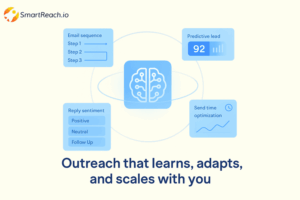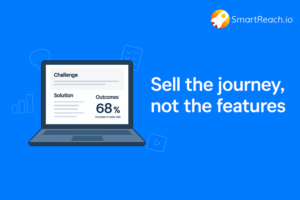How to Sell to Developers Without Technical Jargon Guide
Developers instantly tune out when they hear meaningless buzzwords or detect salespeople pretending to understand their work.
Yet many sales teams still approach technical buyers with either an avalanche of misused jargon or patronizing oversimplifications. The solution isn’t becoming a developer yourself, it’s learning to communicate genuine value in clear language that respects their intelligence.
This guide shows proven strategies from successful developer-focused companies that have mastered the balance between technical credibility and accessible communication.
Understanding How Developers Think and Make Decisions
Developers approach purchasing decisions completely differently than most business buyers. They’re naturally skeptical of traditional sales tactics and marketing claims, they want evidence, not promises.
According to research, 59% of developers influence technology purchasing decisions in their organizations, making them critical stakeholders even when they’re not the final decision-makers.
What drives developer decisions?
- Functionality over flash: They value precision and practical solutions over presentations.
- Peer validation: Community recommendations carry more weight than marketing materials.
- Hands-on evaluation: They expect trials, documentation, and sandboxes for testing.
- Evidence-based assessment: They want proof, not promises.
Developers also have a deep aversion to hype and exaggeration, especially technical jargon. They possess the technical knowledge to spot inflated claims immediately, and once your credibility is damaged, it’s nearly impossible to recover.
One practical way to avoid falling into the jargon trap is to refine messaging with tools designed to humanize technical copy.
Platforms like Humanizer AI can take overly mechanical or jargon-heavy text and reframe it into clear, conversational language that respects a developer’s intelligence while staying approachable.
This makes it easier for sales and marketing teams to communicate value without misusing technical terms, ensuring copy feels natural, authentic, and aligned with how developers actually process information.
The Problem with Technical Jargon in Sales Conversations
When non-technical salespeople try to sound technical, the results are usually disastrous.
| Problem | Impact | Example |
|---|---|---|
| Credibility suicide | Using technical terms incorrectly signals you don’t understand your own product. | Calling a REST API “AI-powered” without ML components. |
| Creating confusion | Buzzwords without explanations create ambiguity. | “Enterprise-grade seamless integration” without specifics. |
| Wrong focus | Technical specs without connecting to problems. | Listing RAM specs instead of performance benefits. |
| Misrepresenting capabilities | Using jargon to mask limitations. | Calling basic automation “intelligent orchestration”. |
Many sales teams fall into the jargon trap because they believe sounding technical establishes credibility. In reality, developers respect honesty about your technical knowledge limits far more than attempts to fake expertise.
5 Steps to Communicate Value Without Overwhelming Developers
1. Research Their Actual Technical Environment
Before any sales conversation, understand the developer’s specific technical context. This research isn’t about memorizing technical terms, it’s about understanding their work so you can frame your solution in relevant terms.
Key questions to ask:
- “What development frameworks is your team currently using?”
- “What are the main components of your current tech stack?”
- “Where are the friction points in your current development workflow?”
Understanding whether you’re talking to frontend developers, backend engineers, or DevOps specialists helps you focus on problems most relevant to their specific role.
2. Lead with Problems You Solve, Not Features You Have
Developers care about solving specific technical challenges, not abstract product capabilities. Here are two approaches for selling a CI/CD automation tool:
❌ Feature-focused approach: “Our enterprise-grade CI/CD platform leverages AI-powered analytics with seamless integration capabilities and comprehensive security orchestration to optimize your DevOps pipeline.”
✅ Problem-focused approach: “We help development teams reduce pipeline build failures from 15% to under 3% by automatically catching configuration errors before deployment. Our automated security scans run in parallel with your builds, so you find vulnerabilities without adding 20 minutes to your deployment time.”
The problem-focused approach provides specific metrics, addresses concrete pain points, and shows measurable outcomes that developers can evaluate against their current situation.
3. Use Clear Language with Strategic Technical Depth
You don’t need to eliminate all technical terminology, just use it accurately and appropriately. Match your technical depth to the conversation context:
- Use analogies: “Our caching system works like a smart grocery shopper who remembers what’s already in your pantry.”
- Break down complexity: “There are three main ways our API handles authentication…” Be honest about limits: “That’s a great technical question. Let me connect you with our solution architect.”
Clear language doesn’t mean oversimplified language. Respect developers’ intelligence while making your points accessible.
4. Provide Hands-On Proof Through Documentation and Demos
Developers trust what they can verify themselves. Quality documentation is often more persuasive than any sales presentation.
Essential documentation components:
| Component | Requirements | Purpose |
|---|---|---|
| Interactive API Explorer | Live testing, multi-language examples, version comparison | Immediate hands-on evaluation |
| Code Samples | Copy-paste ready snippets in JavaScript, Python, Java with error handling | Quick integration assessment |
| Getting Started Guides | Framework-specific tutorials for React, Django, Express | Realistic implementation preview |
| Troubleshooting Section | Error code catalog with exact causes and solutions | Implementation confidence |
SmartReach.io’s sales engagement platform takes this documentation approach further by allowing sales teams to deliver technical resources through precisely timed sequences.
Instead of overwhelming developers with all the documentation upfront, teams can share API examples, code samples, and integration guides based on specific engagement signals.
This ensures developers receive the most relevant technical content exactly when they’re evaluating implementation details, increasing the likelihood of meaningful technical discussions.
5. Build Long-Term Relationships Through Value-First Interactions
The best developer relationships develop gradually through consistent value delivery. This isn’t about playing the short game.
• Share relevant technical articles and industry insights. • Participate authentically in developer communities. • Provide educational content without immediate sales expectations. • Respond quickly to technical questions. • Connect developers with appropriate technical resources.
This approach establishes you as a trusted advisor rather than just another vendor. For sales teams managing multiple developer relationships, platforms like SmartReach.io help maintain authentic engagement at scale through automated value-driven follow-ups and technical content libraries that support the gradual relationship building developer audiences require.
Understanding Developer Communities and Engagement Rules
Database Performance Communities:
| Platform | Specific Locations | Engagement Rules |
|---|---|---|
| Stack Overflow | Tags: [postgresql], [mysql], [performance] | Provide schema, sample data, execution plans |
| r/database, r/PostgreSQL, r/homelab | Include lab specs, version info, show prior research |
DevOps and Infrastructure Communities:
| Platform | Specific Locations | Key Guidelines |
|---|---|---|
| Discord | DevOps, SRE, & Infrastructure (DSI) ~20k members | Use appropriate channels, provide configs/manifests |
| Slack | Official Kubernetes Slack, AWS Community Builders | Disclose vendor affiliations, avoid unsolicited pitching |
Universal community etiquette:
- Be transparent about your role and commercial interests.
- Provide specific technical details, not vague requests.
- Search existing discussions before posting.
- Respect community codes of conduct.
How Pricing Models Impact Developer Decisions?
Different pricing approaches significantly influence how developers evaluate and adopt solutions:
Transparent Tiered Model (Free, Pro, Enterprise)
Advantages:
- Clear entry point with functional free tier
- Predictable budgeting and obvious upgrade paths
- Self-service velocity for instant experimentation
Disadvantages:
- Decision paralysis with unclear tier differences
- Risk of overpaying for bundled unused features
- Administrative overhead for mixed-tier organizations
Usage-Based Pricing
Advantages:
- Cost alignment with actual usage
- Low-commitment entry with elastic scaling
- Natural cost attribution across teams
Disadvantages:
- Unpredictable costs hamper budget planning
- Bill shock risk from usage spikes
- Constant monitoring overhead
Enterprise Sales Model
Advantages:
- Custom terms with volume discounts
- Bundled support, SLAs, and compliance features
Disadvantages:
- High friction slowing experimentation
- Opaque pricing is hindering comparison
Open Source Influence
Impact on evaluation:
- Reduces vendor lock-in concerns with exit options
- Enables low-risk production trials
- Builds trust through code auditability
- May hide the total cost of ownership from operational burden
Essential Technical Concepts for Non-Technical Salespeople
When selling data analytics platforms, understand these five fundamental concepts:
| Concept | Definition | Sales Relevance |
|---|---|---|
| Data Warehouse | Stores structured, curated data with predefined schemas for BI/reporting | Emphasize reliability, fast queries, but higher processing costs |
| Data Lake | Stores raw data at any scale with flexible schemas | Highlight cost-effectiveness, flexibility, but governance needs |
| ETL Process | Extract, Transform, Load – moves and cleans data before storage | Focus on data quality assurance and preprocessing benefits |
| Data Latency | Time delay between data generation and availability in dashboards | Critical for real-time decision making – quantify improvement |
| Batch vs Streaming | Scheduled chunks vs continuous processing | Match processing model to use case requirements |
Common Communication Mistakes That Kill Developer Trust
While building trust is a gradual process, breaking it can happen in an instant. Avoid these critical errors:
- Faking technical knowledge – Pretending to understand concepts you don’t know.
- Using pressure tactics – “This offer expires tomorrow” approaches often backfire.
- Dismissing technical concerns – Treating implementation questions as minor details.
- Making exaggerated claims – Promising capabilities your product doesn’t deliver.
- Ignoring workflow realities – Failing to understand how your solution fits their processes.
- Speaking like marketers – Using superlatives instead of specific, measurable statements.
Once trust is broken, it’s extremely difficult to rebuild with developer audiences.
Building Credibility When You’re Not Technical
You don’t need to be a developer to sell effectively to developers.
Focus on these approaches:
- Own your perspective: Acknowledge limitations while emphasizing business expertise.
- Ask intelligent questions: Show curiosity about technical challenges without pretending knowledge.
- Bring in experts appropriately: Know when to involve technical team members.
- Connect to business outcomes: Link technical capabilities to organizational results.
- Respect their expertise: Treat developers as knowledgeable partners.
- Learn continuously: Build understanding gradually without trying to become a developer overnight.
The goal isn’t becoming technical; it’s establishing yourself as a valuable partner who respects technical expertise.
Adapting Your Approach for Different Developer Roles
Different developer roles have distinct priorities:
| Role | Primary Focus | Communication Approach |
|---|---|---|
| Frontend Developers | User experience, interface performance | Focus on user impact and visual outcomes |
| Backend Developers | System architecture, data management | Emphasize scale, security, and integration |
| DevOps Specialists | Deployment, monitoring, operational efficiency | Address CI/CD pipelines and reliability |
| Technical Leads | Strategic fit, long-term sustainability | Provide both technical depth and business context |
Adjust your communication to address specific concerns while maintaining consistent messaging about core values.
Measuring Success in Developer-Focused Sales
Traditional sales metrics often miss the mark. Focus on these indicators:
Key success metrics:
- Documentation engagement: Depth of technical resource exploration.
- Trial activation: Actual implementation and testing activity.
- Technical question quality: Movement from basic to implementation-specific inquiries.
- Community participation: Product discussions in forums and communities.
- Technical validation depth: Thoroughness of capability evaluation.
- Developer advocacy: Early adopter recommendations to peers.
Modern sales engagement platforms provide deeper visibility into these developer-specific metrics.
SmartReach.io’s analytics track technical content engagement patterns, documentation download behavior, and API testing activity, giving sales teams insight into the developer evaluation process that traditional metrics miss.
This data helps sales managers understand which technical resources actually influence developer decisions and optimize their outreach accordingly.
Developer sales cycles are typically longer but lead to stronger customer relationships and lower churn when managed properly.
Conclusion
Selling to developers doesn’t require becoming a technical expert or mastering complicated jargon. It demands something more fundamental: respecting their intelligence while communicating clearly about specific problems you solve.
The most successful developer-focused sales professionals build trust through honesty, deliver value before expecting commitment, and focus on solving real problems rather than pushing products.
They recognize that developers make decisions based on evidence and peer validation, not sales pressure or marketing claims.
By embracing these principles, you can build genuine relationships with developer audiences that create long-term value for both sides, no jargon required.
Frequently Asked Questions
How to communicate without jargon?
Focus on clear, specific language that describes what something actually does rather than using industry buzzwords. Use concrete examples and analogies that connect to familiar concepts. When technical terms are necessary, define them briefly before using them. Test your communication by asking whether someone outside your field would understand your main points.
What is the difference between jargon and technical language?
Technical language serves a precise purpose by efficiently communicating specific concepts to people with shared knowledge. Jargon, by contrast, often creates unnecessary complexity or exclusivity. Good technical language clarifies while jargon obscures. The key difference is whether the terminology actually improves understanding for your specific audience.
How can you avoid jargon and complex language?
Start by identifying your audience’s knowledge level and communication preferences. Replace vague terms with specific descriptions of what you actually mean. Break complex ideas into smaller, more digestible components. Use visual aids and examples to illustrate concepts rather than relying solely on technical terminology. Have someone from outside your field review your communication for clarity.
Why should we not use jargon while speaking in plain language?
Jargon creates unnecessary barriers to understanding, excludes people who don’t share your specialized knowledge, and often masks imprecise thinking. Using plain language demonstrates respect for your audience, ensures your message reaches more people effectively, and forces you to clarify your own thinking. Plain language also builds trust by showing you value communication over demonstrating insider status.



